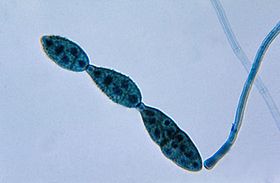- Pleosporales
-
Pleosporales
Temporal range: Eocene–recent
Alternaria sp. Scientific classification Kingdom: Fungi Division: Ascomycota Subdivision: Pezizomycotina Class: Dothideomycetes Subclass: Pleosporomycetidae Order: Pleosporales
Luttr. ex M.E.Barr 1987Families - Cucurbitariaceae
- Delitschiaceae
- Diademaceae
- Didymosphaeriaceae
- Leptosphaeriaceae
- Lindgomycetaceae
- Lophiostomataceae
- Massariaceae
- Massarinaceae
- Melanommataceae
- Montagnulaceae
- Mytilinidiaceae
- Phaeosphaeriaceae
- Phaeotrichaceae
- Pleomassariaceae
- Pleosporaceae
- Sporormiaceae
- Venturiaceae
- Teichosporaceae
- Testudinaceae
- Zopfiaceae
Synonyms - Melanommatales
- Pseudosphaeriales [1]
The Pleosporales is the largest order in the fungal class Dothideomycetes. By some estimates it contains 23 families, 332 genera and more than 4700 species.[2] The majority of species are saprobes on decaying plant material in fresh water,[3] marine,[4] or terrestrial environments, but several species are also associated with living plants as parasites, epiphytes or endophytes[5]. The best studied species cause plant diseases on important agricultural crops e.g. Cochliobolus heterostrophus, causing southern corn leaf blight on maize, Phaeosphaeria nodorum (Stagonospora nodorum) causing glume blotch on wheat and Leptosphaeria maculans causing a stem canker (called blackleg) on cabbage crops (Brassica). Some species of Pleosporales occur on animal dung[6] and a small number occur as lichens [7] and rock-inhabiting fungi.[8] The oldest member of Pleosporales is the extinct genus Margaretbarromyces which was described from Eocene age strata on Vancouver Island, British Columbia.[9]
References
- ^ "Pleosporales". Integrated Taxonomic Information System. http://www.itis.gov/servlet/SingleRpt/SingleRpt?search_topic=TSN&search_value=14054. Retrieved October 12, 2007.
- ^ Kirk PM, Cannon PF, Minter DW, Stalpers JA. (2008). Dictionary of the Fungi (10th ed.). Wallingford, UK: CABI. p. 547. ISBN 9780851998268.
- ^ Shearer CA, Raja HA, Miller AN, Nelson P, Tanaka K, Hirayama K, Marvanová L, Hyde KD, Zhang Z. 2009. The molecular phylogeny of freshwater Dothideomycetes. Studies in Mycology 64: 145–153.[1]
- ^ Suetrong S, Schoch CL, Spatafora JW, Kohlmeyer J, Volkmann-Kohlmeyer B, Sakayaroj J, Phongpaichit S, Tanaka K, Hirayama K, Jones EBG. 2009. Molecular systematics of the marine Dothideomycetes. Studies in Mycology 64: 155–173.[2]
- ^ Zhang Y, Schoch CL, Fournier J, Crous PW, Gruyter J De, Woudenberg JHC, Hirayama K, Tanaka K, Pointing SB, Hyde KD. 2009. Multi-locus phylogeny of the Pleosporales: a taxonomic, ecological and evolutionary re-evaluation. Studies in Mycology 64: 85–102.[3]
- ^ Kruys Å, Eriksson OE, Wedin M. 2006. Phylogenetic relationships of coprophilous Pleosporales (Dothideomycetes, Ascomycota), and the classification of some bitunicate taxa of unknown position. Mycological Research 110:527–536
- ^ Nelsen MP, Lücking R, Grube M, Mbatchou JS, Muggia L, Rivas Plata E, Lumbsch HT. 2009. Unravelling the phylogenetic relationships of lichenised fungi in Dothideomyceta. Studies in Mycology 64: 135–144.[4]
- ^ Ruibal C, Gueidan C, Selbmann L, Gorbushina AA, Crous PW, Groenewald JZ, Muggia L, Grube M, Isola D, Schoch CL, Staley JT, Lutzoni F, Hoog GS De. 2009. Phylogeny of rock-inhabiting fungi related to Dothideomycetes. Studies in Mycology 64: 123–133.[5]
- ^ Mindell, R.A.; Stockey, R.A., Beard, G., & Currah, R.S. (2007). "Margaretbarromyces dictyosporus gen. sp. nov.: a permineralized corticolous ascomycete from the Eocene of Vancouver Island, British Columbia". Mycological Research 111 (6): 680–684. doi:10.1016/j.mycres.2007.03.010. PMID 17601718. http://www.amjbot.org/cgi/reprint/94/3/351.
Categories:- Dothideomycetes
- Lichens
- Pleosporales stubs
Wikimedia Foundation. 2010.
